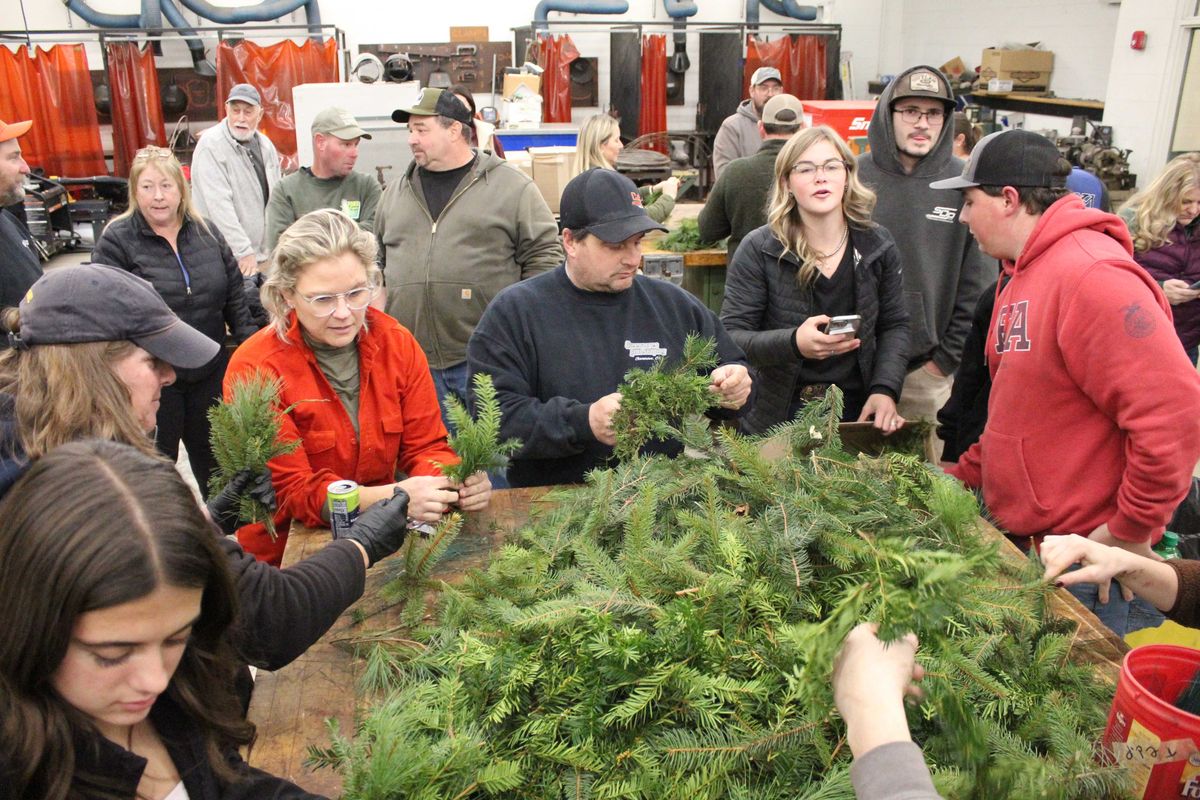Latest News
Built in 2003, 20 Ashley Drive was sold in July 2023 for $560,000 and two years later for $645,000 on 0.84 acres with a four car garage in Woodridge Lake community.
Christine Bates
GOSHEN — In October, all four single-family residential transfers recorded in Goshen were located in the Woodridge Lake development.
The town’s 12-month median sale price held steady at $642,400 — close to September’s record 12-month median of $649,700, which remains the all-time high.
At the end of November, 12 single-family homes were on the market, reflecting the town’s continued tight inventory. Five were listed above $1 million, including two “to-be-built” homes in the Meadow Crest Lane development. Only four homes were priced below the current median of $642,400.
Transactions
197 West Hyerdale Drive — 4 bedroom/3 bath lakeside Woodridge Lake home on 0.9 acres sold by Lloyd J. and Arlene Streisand to David Mandelbaum and Moira J. Dolan for $1,875,000.
20 Ashley Drive — 5 bedroom/3.5 bath home in Woodridge Lake sold by Jennifer and Jon Alex Sheaffer Sr. to Kelly and Michale Santoro for $645,000.
3 Equestrian Drive — 4 bedroom/2.5 bath home on 0.95 acres in Woodridge Lake sold by Sheryl A. and Daniel P. Nemergut to Bryan D. and Elaina J. Fealy for $575,000.
172 Bentley Circle — 5 bedroom/3 bath home in Woodridge Lake sold by Judith A. Juliano to Johanna C. and Toby G. Geiger for $465,000.
* Town of Goshen real estate transfers recorded as sold between Oct. 1 and Oct. 31, 2025, provided by Goshen Town Clerk. Transfers without consideration are not included. Current market listings from Smart MLS. Note that recorded transfers frequently lag closed sales by a number of days. Compiled by Christine Bates, Real Estate Salesperson with William Pitt Sotheby’s International Realty, Licensed in Connecticut and New York.
Keep ReadingShow less
Gov. Ned Lamont (D) speaks at a press conference on thehousing bill in East Hartfordin November. He has since signed the bill into law.
Katy Golvala / CT Mirror
After months of negotiations and debate, Gov. Ned Lamont has signed a controversial omnibus bill that aims to address Connecticut’s dire lack of affordable housing.
Lawmakers passed House Bill 8002 during the special session in mid November, and Lamont signed it into law on Nov. 26.
The bill expands fair rent commissions, eliminates most off-street parking requirements for smaller housing developments and requires towns to create housing growth plans, among other measures.
Lamont vetoed a similar bill that his office had worked to negotiate in June, after the regular session. The governor said he wanted to see a bill that had more town buy-in and called a two-day special session last month to give lawmakers time to work on revising the legislation.
After months of negotiations, the Connecticut Conference of Municipalities and Council of Small Towns stood alongside Lamont at a press conference a few weeks ago to support the new bill.
“This bill tells mayors and first selectmen ‘What do you want your town to look like in five or 10 years? Start planning accordingly. Where do you want that housing to go? Are you going to zone accordingly? What else do you need? We want to be your partner,’” said Lamont at the press conference.
While some Democratic lawmakers said the negotiated bill wasn’t as strong as the one they originally passed, they think it will go a long way toward addressing the affordable housing need in Connecticut.
Homelessness has increased over the past few years, and rent prices have risen. Most studies estimate the state lacks more than 100,000 units of housing that are affordable and available to its low-income renters.
The bill has sparked fierce opposition from groups that say it weakens local control and puts onerous burdens on towns.
Republican lawmakers voted against the bill and criticized the process of passing a bill in special session, which they said did not incorporate enough input from the public.
Keep ReadingShow less
Police Blotter: Troop B
Dec 03, 2025
Police Blotter: Troop B
Police Blotter: Troop B
The following information was provided by the Connecticut State Police at Troop B. All suspects are considered innocent until proven guilty in a court of law.
Route 41 fender bender
On the afternoon of Nov. 17, Carolyn Sirianni, 64, of Sharon was traveling south on Route 41 near the intersection with Beaver Dam Road in Salisbury when another vehicle, a Mini Cooper Countryman driven by Aline Sosne, 77, of Salisbury, turned onto Route 41 without granting right of way. This caused Sirianni’s Suzuki Kizashi Sport to collide with the rear of Sosne’s vehicle, causing minor damage. Neither driver was injured and both vehicles were able to be driven from the scene. Sosne was issued a written warning for failure to grant right of way at a highway junction.
Deer in roadway leads to rear end accident
On the evening of Nov. 18, Thu Do, 53, of Millerton, New York was traveling north on Route 361 in Sharon when a deer in the roadway caused her to come to a complete stop. As she did, Janay Gregory, 21, of Sharon, who was driving a Mazda CX-5, collided with the rear of the Mercedes Benz ML350 that Do was driving, causing minor but functional damage to both vehicles. Neither driver was injured in the incident. Gregory was found to be at fault for the accident and was issued a written warning.
Driver flees parking lot accident
Just before 11 a.m. on Nov. 22, Dianna Dahoney, 58, of Falls Village, was inside Lakeville’s Cozy Spa & Nails when her phone alerted her that her car’s alarm was going off as it was parked in the lot behind the building. She was able to see footage of another vehicle, which she identified as a red 2009 Chevrolet Cobalt with the Virginia plate number TCX5562, backing into the rear of her own vehicle, a Tesla Model Y, leaving paint and scratches on its surface. She also stated she saw the driver of the Cobalt get out of his car, inspect the damage, and then leave the scene. As per the report, the vehicle is stated to belong to “Sebatian Choc Cac” of Winchell Mountain Road in Millerton, New York. Anyone with information regarding this incident is asked to contact Trooper Begley #868 at Kathleen.Begley@ct.gov or the Troop B main line at 860-626-1820.
Single car pole strike
At around 10:30 p.m. on Nov. 22, Bruce Clark, 64, of Sherman, Connecticut was driving east on Route 4 in Cornwall near the intersection with West Drive when he veered into the other lane, ultimately striking a utility pole and coming to a rest atop a metal guardrail. Clark stated he was not injured, though the responding EMT crew advised medical transport to evaluate his head, neck and spine, and he was brought to Waterbury Hospital. His Honda CRV sustained disabling damage to the fender, hood and undercarriage. Clark was issued a citation for failure to maintain lane and failure to keep right on a curve. The case remains active, pending further investigation.
Disorderly conduct arrest
At approximately 5 p.m. on Nov. 24, troopers were dispatched to a North Street address in Norfolk on a report of suspicious activity. Upon arriving, troopers placed Andrew Crawford, 42, into custody for disorderly conduct charges. Crawford was ultimately released on a $2,500 non-surety bond and was scheduled to appear at Torrington Superior Court the next day.
Single car accident
Midday Nov. 27, Ellen McMahon, 79, of Bronxville, New York was traveling north on Route 7 in Cornwall when she lost control of her Subaru Forester, striking a rock embankment on the shoulder. She was evaluated for injuries but declined medical attention. Her vehicle was disabled in the incident and had to be towed. She was issued a written warning for failure to maintain lane.
The Lakeville Journal will publish the outcome of police charges. Send mail to P.O. Box 1688, Lakeville, CT 06039, Attn: Police Blotter, or email editor@lakevillejournal.com
Keep ReadingShow less
Fresh pine is bound into wreaths by attendees of Housatonic Valley FFA’s holiday production night Monday, Nov. 24.
Kellie Eisermann
FALLS VILLAGE — The Housatonic Valley FFA kicked off its annual wreath-making tradition with the first of two holiday production nights on Monday, Nov. 24, at Housatonic Valley Regional High School.
Students, alumni, families, teachers and friends gathered to help create wreaths for the FFA holiday store, which opened Saturday, Nov. 29.
Wreath-making unfolded in several steps. Pine boughs were trimmed from tree limbs on the garage floor, then passed along to teams of bunch-makers working at tables in the FFA garage. The tied bundles were handed off to the final assemblers, who crafted the finished wreaths.
Organizers say the production nights give students and advisors a jump-start on preparing for the holiday store while filling the FFA shop with “light, laughter and teamwork.”
The second production night was scheduled for Wednesday, Dec. 3, 6:30 to 8:30 p.m. in the Ag Ed wing.
Keep ReadingShow less
loading









